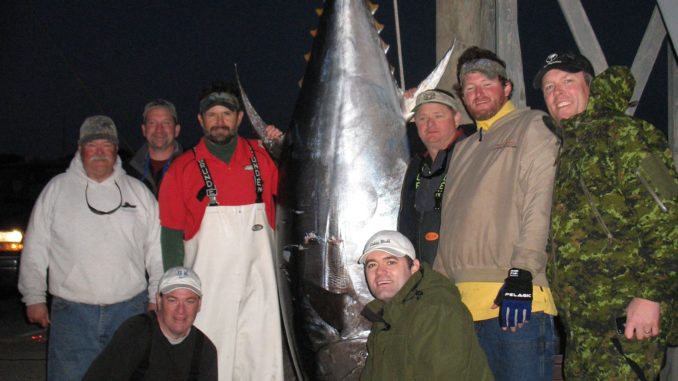
Outlook for Atlantic bluefin tuna is mixed, but a huge group of fish is about to reach spawning age. You can almost hear North Carolina fishermen cheering.
Commercial fishermen pursue bluefin tuna in the Atlantic, Pacific and Indian oceans. Bringing as much as $100 per pound at wholesale auctions, they represent the gold bar, the dollar and the euro rolled into one.
Nowhere is the competition as keen as in the north Atlantic and the Mediterranean Sea. Long ago, maritime nations agreed to manage shares of tuna using the best science to determine how many fish could be harvested without damaging the population, and the share or allocation to each nation’s fleet.
The organization that determines allocations is the International Commission for the Conservation of Atlantic Tunas (ICCAT). ICCAT’s determinations in US waters are implemented by the National Marine Fisheries Service (NMFS), which supplies and interprets much of the scientific and fisheries data. Other institutions provide and interpret data on the Mediterranean populations.
Giant bluefin tuna pass through North Carolina waters from November through February, chasing food from the beach to the Gulf Stream. The closest sportfishing ports are Hatteras and Morehead City, but boats from everywhere converge wherever the bluefins follow bait.
Bluefins feed from top to bottom and around the clock. An 805-pound bluefin tuna caught on March 12, 2011, by the Sea Breeze out of Oregon Inlet Fishing Center is North Carolina’s state record, but not the largest landed from a Tarheel State port. In Dec. 2006, an 875-pound bluefin landed at Morehead City was butchered and sold, which disqualified it as a sportfishing record. The 2011 fish wasn’t sold, and it displaced the previous record of a 744-pound bluefin caught off Oregon Inlet in 1995. Most bluefin tuna are caught and released, with different slot-size and numerical take limits imposed on commercial and recreational fishermen.
Although juvenile tuna occasionally cross the ocean to feed in the same place, adults only spawn in their home waters. Our western tuna breed in the Gulf of Mexico, while the eastern tuna breed in the Mediterranean and possibly elsewhere.
Today, we have a modern fishing fleet, but decades ago, foreign fleets were cleaning out U.S. coastal ocean fishing stocks and destroying habitat with destructive, bottom-ripping gear. The U.S. finally responded by instituting a 200-mile US Exclusive Economic Zone (EEZ) that made fishing subject to U.S. law, and funded the formation of a modern U.S. commercial fishing fleet.
The U.S. has other laws with overlapping benefits. Today, U.S. law protects bluefin tuna from excessive harvest in our EEZ, from damaging spawning habitat in the Gulf of Mexico by energy companies, and from commercial fishing for large tuna on their spawning grounds.
Across the ocean, European and Asian fleets are overfishing the much larger Mediterranean tuna stock, which hasn’t had a recent good year-class to replace fish being taken. This harvest is bloody and controversial, for images of huge, bleeding doe-eyed tuna will always grab public attention. Commercial fishermen are standard bogeymen for incidental or intentional by-catch of sea turtles, porpoises, sharks, and more recently in North Carolina, striped bass. For every villain yearning to be invisible, there’s a superhero yearning to be noticed for publicity, new members and donations.
The simplest tool to protect the bluefins that frequent U.S. waters is the Endangered Species Act (ESA), managed at sea by NMFS. Under the ESA, listed species are considered threatened or endangered, and their breeding and feeding habitats are protected.
Enter the Center for Biological Diversity (CBD), comprised of environmental activists and attorneys experienced in legal remedies to illegal problems. In May 2010, the CBD petitioned NMFS to list Atlantic bluefin tuna as endangered under the ESA. NMFS assigned 10 of its scientists to a newly formed Atlantic Bluefin Tuna Status Review Team to consider the petition. This past May 20, it published the 100-page Status Review Report of Atlantic Bluefin Tuna.
NMFS experts addressed whether bluefin tuna were subject to the ESA. They described the biology of the tuna from egg to table, spawning times and locations, larval growth, migrations and statistical stock analysis. They applied fishery techniques to calculate population size, the total size of the breeding stock, annual reproductive success, participation and value of commercial and recreational fisheries, relationship of western to eastern Atlantic bluefin tuna, predators (white and mako sharks, killer and pilot whales), diseases, climate change, ocean acidification, adverse effects of aquaculture here, pollution from endocrine disruptors and the impact of the Deepwater Horizon blowout that coincided with the 2010 bluefin tuna annual spawning in the Gulf of Mexico.
NMFS compared alternative growth and reproduction models, implementation of ICCAT allocations and the recent requirement to use weak hooks on Gulf of Mexico long-lines, hooks that would break under pressure of a bluefin but not a yellowfin tuna. Finally, since the ESA seeks to protect species in all circumstances by all means necessary, it also conducted an Extinction Risk Analysis.
The report is comprehensive yet concise. The team estimated that a bluefin tuna joins the breeding population at nine years of age. It evaluated the relationship between spawning stock biomass (number and weight of all adults in the breeding population) and annual recruitment. It compared different recruitment models, one of which indicates that the stock has been continually overfished since the 1970s — and the other says it hasn’t. They recognized that western Atlantic bluefin tuna produced an outstanding year class in 2003 that is soon to join the breeding population (in 2012) and promises a great recovery.
The Deepwater Horizon oil spill affected, at worst, 20 percent of the 2010 spawning in the Gulf of Mexico based on satellite imagery of the extent of the surface oil. Another satellite survey came up with much less than 20 percent. An independent report found that larval tuna easily avoided oil, and brief contact had no effects. Even at worst case, a 20-percent mortality would amount to no more than four percent of the spawning stock biomass. No oil-spill effects were detected in adult numbers, but only eight tagged adults were in the Gulf of Mexico before the Deepwater Horizon event, and all survived long afterward.
The extinction risk analyses was run with several projections of spawning stock biomass. It assumed extinction might occur if the population dropped to fewer than 500 adult breeders. Below 500 adult fish, only 10 percent of 2000 models indicated an 80-percent risk of bluefin becoming extinct by 2055 if the yearly allocation is 1,800 tons a year.
Evident but unstated is that the risk can be calculated, and the calculated risk can be reduced by reducing the allocated harvest. Evident and stated was that the team found no basis for listing Atlantic bluefin tuna under the Endangered Species Act. The report concluded that “current impacts … do not represent a substantial risk to the long-term persistence of the species.”

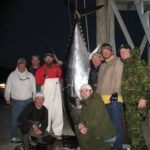
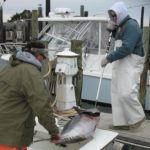
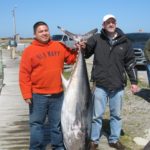
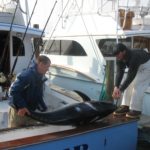


Be the first to comment